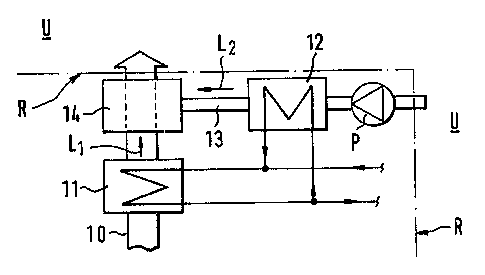Une partie des informations de ce site Web a été fournie par des sources externes. Le gouvernement du Canada n'assume aucune responsabilité concernant la précision, l'actualité ou la fiabilité des informations fournies par les sources externes. Les utilisateurs qui désirent employer cette information devraient consulter directement la source des informations. Le contenu fourni par les sources externes n'est pas assujetti aux exigences sur les langues officielles, la protection des renseignements personnels et l'accessibilité.
L'apparition de différences dans le texte et l'image des Revendications et de l'Abrégé dépend du moment auquel le document est publié. Les textes des Revendications et de l'Abrégé sont affichés :
| (12) Brevet: | (11) CA 2126896 |
|---|---|
| (54) Titre français: | DISPOSITIF PERMETTANT DE REDUIRE LA VAPEUR PROVOQUEE PAR L'AIR HUMIDE EXTRAIT D'UN BATIMENT ET METHODE CONNEXE |
| (54) Titre anglais: | METHOD AND DEVICE FOR REDUCING FOG ARISING FROM HUMID EXHAUST AIR |
| Statut: | Périmé et au-delà du délai pour l’annulation |
| (51) Classification internationale des brevets (CIB): |
|
|---|---|
| (72) Inventeurs : |
|
| (73) Titulaires : |
|
| (71) Demandeurs : |
|
| (74) Agent: | MARKS & CLERK |
| (74) Co-agent: | |
| (45) Délivré: | 2008-08-12 |
| (22) Date de dépôt: | 1994-06-28 |
| (41) Mise à la disponibilité du public: | 1995-01-02 |
| Requête d'examen: | 2001-05-01 |
| Licence disponible: | S.O. |
| Cédé au domaine public: | S.O. |
| (25) Langue des documents déposés: | Anglais |
| Traité de coopération en matière de brevets (PCT): | Non |
|---|
| (30) Données de priorité de la demande: | ||||||
|---|---|---|---|---|---|---|
|
Un procédé et un dispositif pour réduire la quantité du brouillard résultant de l'air humide évacué entrant dans un environnement extérieur. L'écoulement d'air évacué qui est retiré d'une chambre, d'un bâtiment ou d'un processus est refroidi, et par la suite un écoulement de mélange d'air est combiné avec l'air évacué. L'écoulement d'air partiellement ou complètement combiné est évacué à l'extérieur sans créer un important effet de brouillard.
A method and device for reducing the amount of fog arising from humid exhaust air entering into a outdoor environment. The exhaust air flow that is removed from a room, a building or a process is cooled, and thereafter a flow of mixing air is mixed with the exhaust air. The partially or fully combined air flows is then passed outdoors without substantially producing fog.
Note : Les revendications sont présentées dans la langue officielle dans laquelle elles ont été soumises.
Note : Les descriptions sont présentées dans la langue officielle dans laquelle elles ont été soumises.

2024-08-01 : Dans le cadre de la transition vers les Brevets de nouvelle génération (BNG), la base de données sur les brevets canadiens (BDBC) contient désormais un Historique d'événement plus détaillé, qui reproduit le Journal des événements de notre nouvelle solution interne.
Veuillez noter que les événements débutant par « Inactive : » se réfèrent à des événements qui ne sont plus utilisés dans notre nouvelle solution interne.
Pour une meilleure compréhension de l'état de la demande ou brevet qui figure sur cette page, la rubrique Mise en garde , et les descriptions de Brevet , Historique d'événement , Taxes périodiques et Historique des paiements devraient être consultées.
| Description | Date |
|---|---|
| Le délai pour l'annulation est expiré | 2013-06-28 |
| Lettre envoyée | 2012-06-28 |
| Accordé par délivrance | 2008-08-12 |
| Inactive : Page couverture publiée | 2008-08-11 |
| Inactive : Taxe finale reçue | 2008-05-21 |
| Préoctroi | 2008-05-21 |
| Un avis d'acceptation est envoyé | 2007-12-06 |
| Lettre envoyée | 2007-12-06 |
| Un avis d'acceptation est envoyé | 2007-12-06 |
| Inactive : Approuvée aux fins d'acceptation (AFA) | 2007-11-23 |
| Modification reçue - modification volontaire | 2007-06-11 |
| Inactive : Dem. de l'examinateur par.30(2) Règles | 2006-12-12 |
| Modification reçue - modification volontaire | 2006-04-21 |
| Inactive : CIB de MCD | 2006-03-11 |
| Inactive : Dem. de l'examinateur par.30(2) Règles | 2005-10-24 |
| Modification reçue - modification volontaire | 2004-09-02 |
| Inactive : Dem. de l'examinateur art.29 Règles | 2004-03-08 |
| Inactive : Dem. de l'examinateur par.30(2) Règles | 2004-03-08 |
| Inactive : CIB en 1re position | 2003-11-28 |
| Inactive : CIB enlevée | 2003-11-28 |
| Inactive : CIB attribuée | 2003-11-28 |
| Lettre envoyée | 2001-09-13 |
| Inactive : Renseign. sur l'état - Complets dès date d'ent. journ. | 2001-06-18 |
| Lettre envoyée | 2001-06-18 |
| Inactive : Dem. traitée sur TS dès date d'ent. journal | 2001-06-18 |
| Toutes les exigences pour l'examen - jugée conforme | 2001-05-01 |
| Exigences pour une requête d'examen - jugée conforme | 2001-05-01 |
| Demande publiée (accessible au public) | 1995-01-02 |
Il n'y a pas d'historique d'abandonnement
Le dernier paiement a été reçu le
Avis : Si le paiement en totalité n'a pas été reçu au plus tard à la date indiquée, une taxe supplémentaire peut être imposée, soit une des taxes suivantes :
Veuillez vous référer à la page web des taxes sur les brevets de l'OPIC pour voir tous les montants actuels des taxes.
Les titulaires actuels et antérieures au dossier sont affichés en ordre alphabétique.
| Titulaires actuels au dossier |
|---|
| VALMET PAPER MACHINERY INC. |
| METSO PAPER, INC. |
| Titulaires antérieures au dossier |
|---|
| ESKO LALLI |
| JUKKA KOTAJARVI |